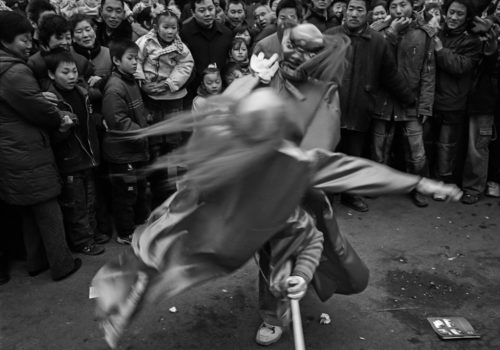Captured in black & white square format gelatin silver films, Hu Li’s spectacular visual celebration of the Chinese New Year, presented through the 204 pages of his newly published photo-book titled “Central Plain”,this documentary is a decade-long pursuit across the rural counties of Henan Province. Generally called “Temple Fair” these gatherings part pagan part religious, in the form of pilgrimage, procession, carnival parade and open-air opera performances, represent the earthly tradition of thanksgiving to the gods for past year’s good harvest and a prayer for the rich crops to come.
Dragon and lion dances, fireworks and firecrackers, trumpets and drums form the indispensable components of a heartfelt symphony to wake up the hibernating nature, to chase away evil spirits and to bring in the auspicious. Each year in the dark chilly winter these fiery, glitzy and loud celebrations represent the needed energy for revival, to pay tribute to fertility and the continual cycle of reproduction and growth. Ten years ago Hu Li had already achieved a creative reinterpretation of the traditional SHEHUO festival of fire in Shaanxi Longxian, by staging the opera-costumed and face-painted actors standing in the snow-covered fields in a Cosplay-like installation, mixing documentary with conceptual in a form of spiritual photography seldom seen in China.
French sinologist Henri Maspero wrote in his “Mythologies of Modern China” in 1928: “It is often said that the Chinese have three religions, Confucianism, Buddhism and Taoism; by that we do not mean that some are Taoists, some Buddhists, others Confucianists, but that each Chinese individually is a follower of the three religions at the same time. This is one of those misconceptions. (…) Chinese people do not practice three religions together, nor each of the three separately.
Little by little, in the course of the ages, a popular religion has been formed, which has borrowed various traits from all three, but which is distinct from them, and must be considered as a separate system.” Hu Li’s book “Central Plain” actualizes Maspero’s observations. Those worshippers indeed bow to all supernatural beings without discrimination: the FO (Buddha), the PUSA (Bodhisatva), TIANJUN (Venerable Celestial), the XIAN (Immortal), the DI (Emperor), the HOU (Goddess) and the SHEN (God). That of course include a bit of Animism – Shamanism, plus the SHENG (Saint Confucius) and the General GUAN, two key figures of the omnipresent country temples Wen Miao and Wu Miao (Temple of Literature for the Confucian scholars and Temple of Martial Arts for the military). For the Chinese commoners, all these gods or deities are of the same nature, and hardly distinguishable from one another except by the more or less extensive power they enjoy.
And these supernatural beings are all revealed here, in representation in Hu Li’s pictures: they are disguised, costumed, with painted faces, all these dancers and child-actors parade on stilts as if they are meant to take us to a higher dimension, to transcend the materialistic world. Although this is China’s back country; that these traditions still exist constitute an extraordinarily comforting fact, that in these remote villages and counties, away from the fast growing cities, true humanity will ultimately join the timeless and the universal.
Jean Loh
Jean Loh is a photography critic and curator based in Shanghai, China.
Hu Li, Danser pour les dieux
January 14 to March 30, 2017
Galerie Beaugeste
210 Taikang Rd, DaPuQiao,
Shanghai Shi
China, 200025
















